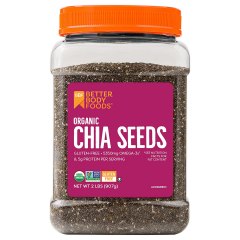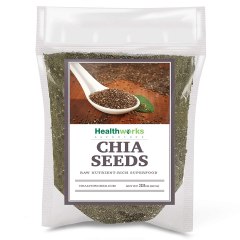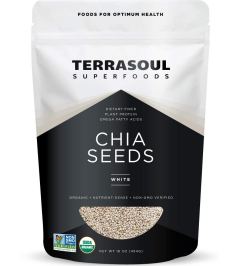BestReviews is reader-supported and may earn an affiliate commission. Details

Our cooking expert recommends this versatile product for its soft, chia-pudding texture.
These seeds have a neutral taste that enhances the food you mix them into. Delivers extra fiber and protein you want in recipes. Ships in a jar instead of a plastic bag, making it easier to access the seeds. Certified organic chia seeds.
Some quality control issues reported with plant matter mixed in with the seeds.

Excellent quality of raw chia seeds that are delivered at a desirable price per ounce.
Has a neutral taste that's perfect to mix into other types of foods to add health benefits. Gives you the fiber, protein, and omega fats you want from chia seeds. Delivers just the right level of texture when adding the seeds to a recipe.
Bag occasionally ships with foreign particles in it. Some bags have quality control problems with holes in the plastic.

It's expensive, but you'll appreciate the quality control in this organic product.
Fully USDA certified organic product that's non-GMO, gluten-free, and vegan. Delivers the extra protein, omega fats, and fiber you expect from chia seeds. Clean, organic product with little to no foreign plant matter in the bag.
Far more expensive per pound than other chia seeds products. Sometimes has an odd odor.

Good quality of organic chia seeds that have a neutral taste; earns our expert's approval.
Good price per ounce. Works well as a vegan option for an egg substitute. High levels of protein, omega fats, and fiber. Certified organic chia seeds that won't affect the taste of foods where you mix the seeds.
Occasional problems with quality control, product contamination, and product freshness.

Nice price per ounce for black organic chia seeds, which earns it our expert's praise.
Gives you the omega fats, proteins, and fiber you want. USDA-certified organic quality. Works well as a mix-in for baking or smoothies. Offered at a reasonable price for an organic product.
Sometimes will have foreign plant matter in the bag. Some problems with quality of seal on bag.

We recommend these products based on an intensive research process that's designed to cut through the noise and find the top products in this space. Guided by experts, we spend hours looking into the factors that matter, to bring you these selections.

Chia seeds are teeny tiny seeds that pack a densely nutritious punch. Originating in Mexico and South America, where they were highly valued by the ancient Aztecs and the Maya, these seeds are nowadays championed as a superfood. They are full of omega-3s, fiber, protein, antioxidants, and essential vitamins and minerals.
Chia seeds can be black, white, or brown, but it’s generally the black or white granules that are added to smoothies, acai bowls, protein bars, salads, soups, and more to provide texture, mild flavor, and nutrition. They carry a host of health benefits, including improved heart health, stronger bones, better skin, and balanced blood sugar. And because these little seeds expand once they hit your stomach, they can help keep you feeling fuller longer.
If you’ve never heard of this superseed, don’t worry, we’ve got you covered.

Although these flattened oval seeds measure about 2.1 millimeters in length, they are rich in protein, fiber, and calcium, making them attractive to those on a plant-based diet. They are also a great source of planted-based omega-3 fatty acids called alpha-linolenic acid (ALA). They have high levels of manganese, magnesium, and phosphorus, all essential minerals the body needs. Chia seeds are also high in antioxidants, which fight free radical damage.
In addition, chia seeds are also a good source of vitamins A, B, D, and E and minerals like iron, copper, zinc, niacin, potassium, and thiamine.
Packed with all these phytonutrients, chia seeds provide a host of health benefits.
Antioxidants provide anti-aging (especially with the skin) and anticancer properties.
High fiber content helps digestion and aids weight loss.
Omega-3s may reduce the risk of heart disease.
Calcium and manganese reduces the risk of osteoporosis and builds strong bones.
ALA and fiber help balance blood sugar.
High-protein, low-carb profile boosts energy, stamina, and athletic performance.
Amino acid content (they contain all nine) promotes muscle building.
Other reported health benefits may include reduced inflammation, better oral health, hydration support, and protection against diabetes.
Hopefully by now you’re convinced chia seeds are good for you, so how the heck do you eat them anyway? Because these seeds are so miniscule and quite bland to the taste, they’re actually very easy to incorporate into your diet.
Quick bites: They can be eaten raw or mixed into water to form a gel that’s great as a snack or before workouts.
Mix it up: Most commonly, chia seeds are blended into smoothies or sprinkled on top of yogurts, salads, cereals, or rice dishes. Chia pudding recipes are also popular.
Get baking: They can be used in baking, and can be switched in as an egg substitute for vegan recipes. Because they absorb water, they’re great for thickening sauces. Also, did we mention they’re naturally gluten-free?
Chia seeds are sold in two colors: white and black. There is no nutritional difference between the colors. You may find that a recipe calls for a certain color merely for aesthetic purposes.
Brown chia seeds should be avoided as their color is an indicator that the seeds didn’t develop fully (possibly due to a lack of sunlight or other factors). They lack the high nutritional value of white and black seeds and often have a bitter taste.
Chia seeds come in plastic bags or jars. Jars may be easier for some to access the seeds. When selecting bags, check for a resealable, Ziploc-like opening for better storage.
Many manufacturers offer chia seeds that were cultivated without the use of pesticides, synthetic fertilizers, and other chemicals that aren’t awesome for your health.
Low-priced chia seeds cost about 21 to 37 cents per ounce. Even though they’re cheaper, you can still find organic and non-GMO options in this price bucket.
Mid-priced chia seeds range from 48 to 54 cents per ounce.
High-end chia seeds range from around 67 cents to more than a dollar per ounce. These are premium brands that are certified organic.
Unlike flaxseed, you don’t need to grind chia seeds before use to unlock their nutritional value. Chia seed powder (ground or “milled” chia seeds) is sold mostly for culinary purposes.
To add crunch to your morning oatmeal or porridge, sprinkle in some chia seeds. Be aware they will swell when they absorb liquid from wet dishes.
Soak one-fourth cup of chia seeds in 1 cup of water or nut milk for 20 minutes to make a tapioca-like pudding. This concoction can be refrigerated for taste.
To use chia seeds as an egg substitute, mix 1 tablespoon of ground chia seeds with 3 tablespoons of water per egg in the recipe.
Remember ch-ch-ch-chia pets? You can make your own by sprouting these seeds in dirt in an animal-shaped pot (don’t forget to water). Chia sprouts are also edible and great for salads.

A. The recommended amount is 1.5 tablespoons twice a day. Be aware that increasing your fiber intake can lead to digestive upset, like loose bowels, so we recommend starting at a lower dose and gradually increase. As always, when increasing your fiber, be sure to drink plenty of fluids.
A. Some nutrition experts recommend soaking chia seeds before eating to make them more digestible. The trend to soak grains, seeds, and legumes (also known as “sprouting”) is believed to make them more digestible by releasing enzyme inhibitors that are designed to protect the seed. This process is also believed to increase the amount of nutrients available. However, this is a topic up for debate, and it certainly won’t hurt you to eat chia seeds raw.
A. Chia seeds are best stored in a plastic or glass container with a tight-fitting lid. It’s best to store them in a dark, cool place like a pantry. You can also store them in the fridge, although it’s not necessary. Chia seeds can last two to four years without going rancid if stored properly.
A. Due to chia seeds’ soluble fiber content, and the fact that their outer shell can absorb ten times their weight in liquid, when mixed with water, chia seeds form a gel. This gel was used by natives of Central and South America as “the running food” to give hydration and endurance for conquests and for running long distances between settlements. When ingested, researchers believe that this gel creates a barrier between carbs and enzymes in the stomach and slows the conversion of carbs to sugar, giving you an energy boost.
Get emails you’ll love.
Learn about the products you’re wondering if you should buy and get advice on using your latest purchases.
